CHAPTER VII
FIRST AID AND LIFE SAVING
Major Charles Lynch, Medical Corps, U. S. A. Acting for the American Red Cross
PREVENTION OF ACCIDENTS
General
Considerably over a million persons are seriously injured in the United States each year. The enormous loss of life and the great suffering involved certainly demand that every boy scout do what he can to improve conditions in this respect. Some accidents happen under all circumstances, but, on the other hand a great many accidents are avoidable and probably quite one half of the injuries which occur in the United States yearly could be prevented if common care were exercised.
Panics and Their Prevention
In case of a panic, at an in-door assembly, scouts, if they live up to their motto, “Be Prepared,” will be able to save hundreds of lives. There is usually plenty of time for people to get out of a building if the exits are not blocked by too many crowding them at once. One should, if possible, try to arrange to have the performance go on, and the others could reassure the people and get them to go out quietly through the exits provided. Almost all scouts know how quickly and safely our school buildings are cleared by means of the fire drill.
Fires
Fires constitute a danger as great as panics, and scouts should be equally well informed what to do in case of fire. It is the duty of a scout to know how to prevent fires. Many fires are caused by carelessness. Never throw away a lighted match, for it may fall on inflammable material and start a fire. Reading in bed by the light of a lamp or candle is dangerous, for if the reader goes to sleep the bed clothing is likely to catch fire. A scout may often have to dry his clothes before a fire and if so, they should be carefully watched. Hot ashes in wooden boxes, or in barrels, are responsible for many fires. In camp, dry grass should be cut away from the locality of the camp fire; and not to put out a camp fire on leaving a camp is criminal. Many of the great fires in our forests have been due to carelessness in this respect. Fires also result frequently from explosions of gas or gunpowder. A room in which the odor of gas is apparent should never be entered with a light, and in handling gunpowder a scout should have no matches loose in his pockets.
How To Put Out Burning Clothing
If your own clothing should catch fire do not run for help as this will fan the flames. Lie down and roll up as tightly as possible in an overcoat, blanket, or rug. If nothing can be obtained in which to wrap up, lie down and roll over slowly at the same time beating out the fire with the hands. If another person’s clothing catches fire, throw him to the ground and smother the fire with a coat, blanket, or rug.
What To Do in Case of Fire
A fire can usually be put out very easily when it starts, and here is an occasion when a scout can show his presence of mind and coolness. At first a few buckets of water or blankets or woollen clothing thrown upon a fire will smother it. Sand, ashes, or dirt, or even flour, will have the same effect.
If a scout discovers a building to be on fire, he should sound the alarm for the fire department at once. If possible he should send some one else, as the scout will probably know better what to do before the fire-engine arrives. All doors should be kept closed so as to prevent draughts. If you enter the burning building, close the window or door after you, if possible, and leave some responsible person to guard it so it will not be opened and cause a draught. In searching for people, go to the top floor and walk down, examining each room as carefully as possible. If necessary to get air while making the search, close the door of the room, open a window, and stick the head out until a few breaths can be obtained. Afterward close the window to prevent a draught. If doors are found locked and you suspect people are asleep inside, knock and pound on doors to arouse them. If this produces no results, you will have to try to break down the door. While searching through a burning building it will be best to tie a wet handkerchief or cloth over the nose and mouth. You will get a little air from the water.
Remember the air within six inches of the floor is free from smoke, so when you have difficulty in breathing, crawl along the floor, with the head low, dragging any one you have rescued behind you.
If you tie the hands of an insensible person together with a handkerchief and put them over your head, you will find it fairly easy to crawl along the floor dragging him with you.

Learning by doing
Never jump from a window unless the flames are so close to you that this is the only means of escape.
If you are outside a buildling, put bedding in a pile to break the jumper’s fall, or get a strong carpet or rug to catch him, and have it firmly held by as many men and boys as can secure hand holds.
In country districts, scouts should organize a bucket brigade which consists of two lines from the nearest water supply to the fire. Scouts in one line pass buckets, pitchers, or anything else that will hold water from one to another till the last scout throws the water on the fire. The buckets are returned by the other line.
Drowning
Drowning accidents are very common. Every scout should know how to swim and to swim well, but this is not all that is necessary. He should also know how to prevent accidents that may result in drowning. In summer, boating and bathing accidents are common. Remember a light boat is not intended for heavy seas; do not change seats except in a wide and steady boat; and above all things do not put yourself in the class of idiots who rock a boat.
At the sea-shore, unless you are a strong swimmer, do not go outside the life line, and if the undertow is strong be careful not to walk out where the water is so deep it will carry you off your feet. Very cold water and very long swims are likely to exhaust even a strong swimmer and are therefore hazardous unless a boat accompanies the swimmer.
Rescue of the Drowning
(See pages 279 to 285)
Ice Rescue
To rescue a person who has broken through the ice you should first tie a rope around your body and have the other end tied, or held, on shore. Then secure a long board or a ladder or limb of a tree, crawl out on this, or push it out, so that the person in the water may reach it. If nothing can be found on which you can support your weight do not attempt to walk out toward the person to be rescued, but lie down flat on your face and crawl out, as by doing this much less weight bears at any one point on the ice than in walking. If you yourself break through the ice remember that if you try to crawl up on the broken edge it will very likely break again with you. If rescuers are near, it would be much better to support yourself on the edge of the ice and wait for them to come to you.
Restoring the Drowning and Artificial Respiration
(See pages 286 to 288)
Electric Accidents
For his own benefit and that of his comrades, the scout should know how to avoid accidents from electricity. The third rail is always dangerous, so do not touch it. Swinging wires of any kind may somewhere in their course be in contact with live wires, so they should not be touched.
A person in contact with a wire or rail carrying an electric current will transfer the current to the rescuer. Therefore he must not touch the unfortunate victim unless his own body is thoroughly insulated. The rescuer must act very promptly, for the danger to the person in contact is much increased the longer the electric current is allowed to pass through his body. If possible, the rescuer should insulate himself by covering his hands with a mackintosh, rubber sheeting, several thicknesses of silk, or even dry cloth. In addition he should, if possible, complete his insulation by standing on a dry board, a thick piece of paper, or even on a dry coat. Rubber gloves and rubber shoes or boots are still safer, but they cannot usually be procured quickly.
If a live wire is under a person and the ground is dry, it will be perfectly safe to stand on the ground and pull him off the wire with the bare hands, care being taken to touch only his clothing, and this must not be wet.
A live wire lying on a patient may be flipped off with safety with a dry board or stick. In removing the live wire from the person, or the person from the wire, do this,with one motion, as rocking him to and fro on the wire will increase shock and burn.
A live wire may be safely cut by an axe or hatchet with dry, wooden handle. The electric current may be short circuited by dropping a crow-bar or poker on the wire. These must be dropped on the side from which the current is coming and not on the farther side, as the latter will not short circuit the current before it is passed through the body of the person in contact. Drop the metal bar; do not place it on the wire or you will then be made a part of the short circuit and receive the current of electricity through your body.
What To Do for Electric Shocks
Always send for a doctor, but do not wait for him. Treatment should be given even if the man appears to be dead. Loosen the clothing around neck and body. Proceed to restore breathing by artificial respiration as in drowning. (See pages 286, 287.)
Gas Accidents
The commonest gas encountered is the ordinary illuminating gas. To prevent such gas from escaping in dangerous quantities, leaks in gas pipes should be promptly repaired. Be careful in turning off gas to make sure that gas is actually shut off. It is dangerous to leave a gas jet burning faintly when you go to sleep: as it may go out if pressure in the gas pipe becomes less, and if pressure is afterward increased gas may escape into the room.
Coal gas will escape through red-hot cast-iron, and very big fires in such stoves are dangerous, especially in sleeping rooms. Charcoal burned in open vessels in tight rooms is especially dangerous. In underground sewers and wells other dangerous gases are found. If a lighted candle or torch will not burn in such a place, it is very certain the air will be deadly for any person who enters.
To rescue an unconscious person in a place filled with gas, move quickly and carry him out without breathing yourself. Take a few deep breaths before entering and if possible hold breath while in the place. Frequently less gas will be found near the floor of a building, so one may be able to crawl where it would be dangerous to walk.
What To Do for Gas Poisoning
Proceed to restore breathing by artificial respiration as in drowning. (See pages 286, 287.)
Runaway Horses
The method for checking a horse running away is not to run out and wave your arm in front of him, as this will only cause him to dodge to one side and to run faster, but to try to run alongside the vehicle with one hand on the shaft to prevent yourself from falling, seizing the reins with the other hand and dragging the horse’s head toward you. If when he has somewhat slowed down by this method, you can turn him toward a wall or a house he will probably stop.
Mad Dog
The first thing to do is to kill the mad dog at once. Wrap a handkerchief around the hand to prevent the dog’s teeth from entering the flesh and grasp a club of some kind. If you can stop the dog with a stick you should hit him hard over the head with it, or kick him under the jaw. A handkerchief held in front of you in your outstretched hands will generally cause the dog to stop to paw it before he attempts to bite you. This will give you an opportunity to kick him under the lower jaw.
Another way suggested is to wrap a coat around the left arm and let the dog bite it; then with the other hand seize the dog’s throat and choke him.
FIRST AID FOR INJURIES
General Directions
Keep cool. There is no cause for excitement or hurry. In not one case in a thousand are the few moments necessary to find out what is the matter with an injured man going to result in any harm to him, and of course in order to treat him intelligently you must first know what is the matter. Commonsense will tell the scout that he must waste no time, however, when there is severe bleeding, or in case of poisoning.
If possible, always send for a doctor, unless the injury is a trivial one. Don’t wait until he arrives, however, to do something for the injured person. A crowd should always be kept back and tight clothing should be loosened. If the patient’s face is pale, place him on his back with his head low. If his face is flushed, fold your coat and put it under his head so as to raise it slightly.
In case of vomiting, place the patient on his side. Do not give an unconscious person a stimulant, as he cannot swallow, and it will run down his windpipe and choke him.
If the injury is covered by clothing, remove it by cutting or tearing, but never remove more clothing than necessary, as one of the results of injury is for a person to feel cold. Shoes and boots should be cut in severe injuries about the feet.
Shock
For example, a scout is riding on a trolley-car. The car runs into a loaded wagon. The wagon is overturned and the driver thrown to the pavement. Part of the load falls upon his body and when you reach him he is unconscious. So far as you can find out, nothing else is the matter with him. This is called shock. It accompanies all serious injuries and is itself serious, as a person may die without ever recovering from shock. Of course, there are different degrees of shock. In severe shock the person is completely unconscious or he may be only slightly confused and feel weak and uncertain of what has happened.
In shock always send for a doctor when you can. Before he comes, warm and stimulate the patient in every possible way. Place him on his back with his head low and cover him with your coat or a blanket. Rub his arms and legs toward his body but do not uncover him to do this. If you have ammonia or smelling salts, place them before the patient’s nose so he may breathe them.
This is all you can do when unconsciousness is complete. When the patient begins to recover a little, however, and as soon as he can swallow, give him hot tea or coffee, or a half teaspoonful of aromatic spirits of ammonia in a quarter glass of water.
Warning: Remember always that a person with shock may have some other serious injuries. These you should always look for and treat if necessary.
Injuries in Which the Skin is Not Broken — Fractures
A fracture is the same thing as a broken bone. When the bone pierces or breaks through the skin, it is called a compound fracture, and when it does not, a simple fracture.
A scout is in the country with a comrade. The latter mounts a stone wall to cross it. The wall falls with him and he calls out for help. When the other scout reaches him, he finds the injured scout lying flat on the ground with both legs stretched out. One of these does not look quite natural, and the scout complains of a great deal of pain at the middle of the thigh and thinks he felt something break when he fell. He cannot raise the injured leg. Carefully rip the trousers and the underclothing at the seam to above the painful point. When you have done this the deformity will indicate the location of the fracture. You must be very gentle now or you will do harm, but if one hand is put above where you think the break occurred and the other below it and it is lifted gently you will find that there is movement at the broken point.

Splints for broken thigh
Send for a doctor first, if you can, and, if you expect him to arrive very soon, let your comrade lie where he is, putting his injured leg in the same position as the sound one and holding it there by coats or other articles piled around the leg. But if the doctor cannot be expected for some time, draw the injured limb into position like the sound one and hold it there by splints. Splints can be made of anything that is stiff and rigid. Something flat like a board is better than a pole or staff; limbs broken off a tree will do if nothing else can be found. Shingles make excellent splints. In applying splints remember that they should extend beyond the next joint above and the next joint below; otherwise, movements of the joint will cause movement at the broken point. With a fracture of the thigh, such as that described, the outer splint should be a very long one, extending below the feet from the arm pit. A short one extending just below the knee will do for the inner splint. Splints may be tied on with handkerchiefs, pieces of cloth torn from the clothing, or the like. Tie firmly but not tight enough to cause severe pain. In a fracture of the thigh it will also be well to bind the injured leg to the sound one by two or three pieces of cloth around both. The clothing put back in place will serve as padding under the splint, but with thin summer clothing it is better to use straw, hay, or leaves in addition. Fractures of the lower leg and of the upper and lower arm are treated in the same way with a splint on the inner and outer sides of the broken bone. A sling will be required for a fracture of the arm. This may be made of the triangular bandage, or of a triangular piece of cloth, torn from your shirt.
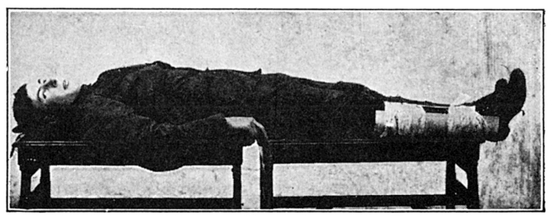
Splints for broken leg
The Red Cross First Aid Outfit is very convenient to use in fractures as well as in other injuries. The gauze bandage may be used for the strips to tie on the splints and the triangular bandage for an arm sling; or, if a sling is not needed, for strips to fix the splints firmly in place.
Compound Fractures
The edges of a broken bone are very sharp and may cut through the skin at the time of an injury, but more often afterward, if the injured person moves about or if the splints are not well applied so as to prevent movement at the point where the bone is broken. If a compound fracture has occurred, the wound produced by the sharp bone must always be treated first. The treatment is the same for any other wound.

Splints and sling for fracture of upper arm
Warning: You will not always be able to tell whether or not a fracture has occurred. In this case do not pull and haul the limb about to make sure, but treat as a fracture. There will always be a considerable amount of shock with fracture and this must also be treated.
Bruises
Everybody has suffered from a bruise at some time in his life and knows just what it is. A slight bruise needs no treatment. For a severe one. apply very hot or very cold water to prevent pain and swelling.
Sprains
A scout slips and twists his ankle and immediately suffers severe pain, and in a little while the ankle begins to swell The sprained joint should be put in an elevated position and cloths wrung out in very hot or very cold water should be wrapped around it and changed very frequently. Movement of any sprained joint is likely to increase the injury, so this ought not to be permitted. Walking with a sprained ankle is not only exceedingly painful but it generally increases the hurt.
Dislocation
A dislocation is an injury where the head of a bone has slipped out of its socket at a joint. A scout is playing foot-ball. He suddenly feels as though his shoulder has been twisted out of place. Comparison with the other side will show that the injured shoulder does not look like the other one, being longer, or shorter, and contrary to the case with fracture there will not be increased movement at the point of injury but a lessened movement. Do not attempt to get a dislocated joint back in place. Cover the joint with cloths wrung out in very hot or very cold water, and get the patient into the hands of a doctor as soon as possible.
Injuries in Which the Skin is Broken
Such injuries are called wounds. There is one very important fact which must be remembered in connection with such injuries. Any injury in which the skin is unbroken is much less dangerous, as the skin prevents germs from reaching the injured part. The principle to be followed in treating a wound is to apply something to prevent germs from reaching the injury.
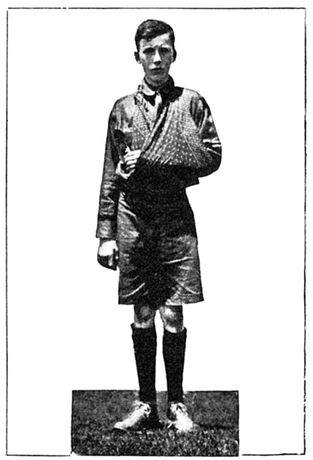
Triangular sling for arm
All wounds unless protected from germs are very liable to become infected with matter, or pus. Blood poisoning and even death may result from infection. To prevent infection of wounds, the scout should cover them promptly with what is called a sterilized dressing. This is a surgical dressing which has been so treated that it is free from germs. A number of dressings are on the market and can be procured in drug stores. In using them, be very careful not to touch the surface of the dressing which is to be placed in contact with the wound. The Red Cross First Aid Dressing is so made that this accident is almost impossible. In taking care of a wound, do not handle it or do anything else to it. Every one’s hands, though they may appear to be perfectly clean, are not so in the sense of being free from germs; nor is water, so a wound should never be washed.
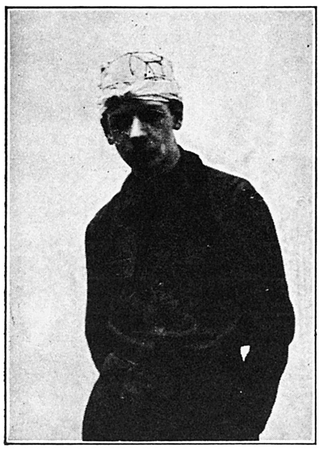
Head bandage
It will be a good thing for a scout always to carry a Red Cross First Aid Outfit, or some similar outfit, for with this he is ready to take care of almost any injury; without it he will find it very difficult to improvise anything to cover a wound with safety to the injured person. If no prepared boil a towel if possible for fifteen minutes, squeeze the water out of it without touching the inner surface, and apply that to the wound. The next best dressing, if you cannot prepare this, will be a towel or handkerchief which has been recently washed and has not been used. These should be held in place on the wound with a bandage. Do not be afraid to leave a wound exposed to the air; germs do not float around in the air and such exposure is much safer than water or any dressing which is not free from germs. Of course you can bind up a wound with a towel not boiled or piece of cotton torn from your shirt, but you cannot do so without the liability of a great deal of harm to the injured person.
Snake Bites
While snake bites are wounds, the wounds caused by venomous snakes are not important as such but because the venom is quickly absorbed and by its action on the brain may cause speedy death. The rattlesnake and the moccasin are the most dangerous snakes in the United States.
In order to prevent absorption of the poison, immediately tie a string, handkerchief, or bandage above the bite. This can only be done in the extremities, but nearly all bites are received on the arms or legs. Then soak the wound in hot water and squeeze or suck it to extract the poison. Sucking a wound is not dangerous unless one has cuts or scrapes in the mouth. Then burn the wound with strong ammonia. This is not aromatic spirits of ammonia, but what is commonly known as strong ammonia in any drug store. Aromatic spirits of ammonia should also be given as a stimulant.
If you have nothing but a string to tie off the wound, be sure to do that and to get out as much poison as you can by squeezing or sucking the wound. A doctor should of course always be sent for when practicable in any injury as severe as a snake bite. Leave your string or bandage in place for an hour. A longer period is unsafe, as cutting off the circulation may cause mortification. Loosen the string or bandage after an hour’s time, so that a little poison escapes into the body. If the bitten person does not seem to be much affected, repeat at the end of a few moments, and keep this up until the band has been entirely removed. If, however, the bitten person seems to be seriously affected by the poison you have allowed to escape into his body, you must not loosen the bandage again, but leave it in place and take the chance of mortification.
Wounds Without Severe Bleeding
These constitute the majority of all wounds. Use the Red Cross Outfit as described in the slip contained in the outfit. The pressure of a bandage will stop ordinary bleeding if firmly bound into place.
Wounds With Severe Bleeding
A scout must be prepared to check severe bleeding at once, and he should then dress the wound. Bleeding from an artery is by far the most dangerous. Blood coming from a cut artery is bright red in color and flows rapidly in spurts or jets. As the course of the blood in an artery is away from the heart, pressure must be applied on the heart side just as a rubber pipe which is cut must be compressed on the side from which the water is coming in order to prevent leakage at a cut beyond. The scout must also know the course of the larger arteries in order that he may know where to press on them. In the arm the course of the large artery is down the inner side of the big muscle in the upper arm about in line with the seam of the coat. The artery in the leg runs down from the centre of a line from the point of the hip to the middle of the crotch, and is about in line with the inseam of the trousers. Pressure should be applied about three inches below the crotch. In making pressure on either of these arteries, use the fingers and press back against the bone. You can often feel the artery beat under your fingers, and the bleeding below will stop when you have your pressure properly made. Of course you cannot keep up the pressure with your fingers indefinitely in this way as they will soon become tired and cramped. Therefore, while you are doing this have some other scout prepare a tourniquet. The simplest form of tourniquet is a handkerchief tied loosely about the limb. In this handkerchief a smooth stone or a cork should be placed just above your fingers on the artery. When this is in place put a stick about a foot long under the handkerchief at the outer side of the limb and twist around till the stone makes pressure on the artery in the same way that your fingers have. Tie the stick in position so it will not untwist.

How to apply first aid dressing
Warning: When using a tourniquet remember that cutting off the circulation for a long time is dangerous. It is much safer not to keep on a tourniquet more than an hour. Loosen it, but be ready to tighten it again quickly if bleeding re-commences.
Another method to stop bleeding from an artery when the wound is below the knee or elbow is to place a pad in the bend of the joint and double the limb back over it holding the pad in tightly. Tie the arm or leg in this position. If these means do not check the bleeding put a pad into the wound and press on it there. If you have no dressing and blood is being lost very rapidly, make pressure in the wound with your fingers. Remember, however, that this should only be resorted to in the case of absolute necessity as it will infect the wound.
Blood from veins flows in a steady stream back toward the heart and is dark in color. From most veins a pad firmly bandaged on the bleeding point will stop the bleeding. If a vein in the neck is wounded, blood will be lost so rapidly that the injured person is in danger of immediate death, so you must disregard the danger of infection and jam your hand tightly against the bleeding point.
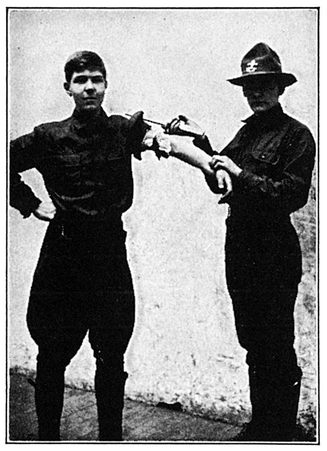
How to apply tourniquet to upper arm
Keep the patent quiet in all cases of severe bleeding, for even if it is checked it may start up again. Do not give any stimulants until the bleeding has been checked unless the patient is very weak. The best stimulant is aromatic spirits of ammonia, one teaspoonful in half a glass of water.
Unconsciousness and Poisoning
Unconsciousness, of course, means lack of consciousness, or, in other words, one who is unconscious knows nothing of his surroundings or of what is happening. A person may, however, be partially, as well as wholly, unconscious.
Unconsciousness may be due to so many causes that, in order to give the best treatment, the scout should first know the cause. Always try to find this out if you can. If you cannot do this, however, you should at least determine whether unconsciousness is due to poison, to bleeding, to sunstroke, or to freezing; for each of these demand immediate, special treatment. If it is not due to one of these causes, and the patient is pale and weak, have him placed with his head low, and warm and stimulate him in every possible way. If the face is red and the pulse is bounding and strong, that patient should have his head raised on a folded coat. No stimulants should be given him and cold water should be sprinkled on his face and chest.
The common causes of unconsciousness are shock, electric shock, fainting, apoplexy and injury to the brain, sunstroke and heat exhaustion, freezing, suffocation, and poisoning. The first two have already been described and the treatment of any form of suffocation in artificial respiration.
Fainting
Fainting usually occurs in overheated, crowded places. The patient is very pale and partially or completely unconscious. The pupils of the eye are natural, the pulse is weak and rapid. The patient should be placed in a lying-down position with the head lower than the rest of the body so that the brain will receive more blood. Loosen the clothing, especially about the neck. Keep the crowd back and open the windows if in-doors so that the patient may get plenty of fresh air. Sprinkle the face and chest with cold water. Apply smelling salts or ammonia to the nose, rub the limbs toward the body. A stimulant may be given when the patient is so far recovered that he is able to swallow.
Apoplexy and Injury to the Brain
Apoplexy and unconsciousness from injury to the brain are due to the pressure of blood on the brain so that they may be described together. Apoplexy is of course much harder to distinguish than injury to the brain as in the latter the scout can always see that the head has been hurt. With both, unconsciousness will usually be complete. Pupils are large and frequently unequal in size, breathing is snoring, and the pulse is usually full and slow. One side of the body will be paralyzed. Test this by raising arm or leg; if paralyzed, it will drop absolutely helpless. Send for a doctor at once. Keep patient quiet and in a dark room if possible. Put in lying-down position with head raised by pillows. Apply ice or cold cloths to head. No stimulants. Drunkenness is sometimes mistaken for apoplexy. If there is any doubt on this point always treat for apoplexy.
Sunstroke and Heat Exhaustion
Any one is liable to sunstroke or heat exhaustion if exposed to excessive heat. A scout should remember not to expose himself too much to the sun nor should he wear too heavy clothing in the summer. Leaves in the hat will do much to prevent sunstroke. If the scout becomes dizzy and exhausted through exposure to the sun he should find a cool place, lie down, and bathe the face, hands, and chest in cold water and drink freely of cold water.
Sunstroke and heat exhaustion, though due to the same cause, are quite different and require different treatment. In sunstroke unconsciousness is complete. The face is red, pupils large, the skin is very hot and dry with no perspiration. The patient sighs and the pulse is full and slow. The treatment for sunstroke consists in reducing the temperature of the body. A doctor should be summoned whenever possible. The patient should be removed to a cool place and his clothing loosened, or better the greater part of it removed. Cold water, or ice, should be rubbed over the face, neck, chest, and in arm pits. When consciousness returns give cold water freely.
Heat exhaustion is simply exhaustion or collapse due to heat. The patient is greatly depressed and weak but not usually unconscious. Face is pale and covered with clammy sweat, breathing and pulse are weak and rigid. While this condition is not nearly as dangerous as sunstroke, a doctor should be summoned if possible. Remove the patient to a cool place and have him lie down with his clothing loosened. Don’t use anything cold externally, but permit him to take small sips of cold water. Stimulants should be given just as in fainting.
Freezing
The patient should be taken into a cold room and the body should be rubbed with rough cloths wet in cold water. The temperature of the room should be increased if possible. This should be done gradually and the cloths should be wet in warmer and warmer water. As soon as the patient can swallow give him stimulants. It will be dangerous to place him before an open fire or in a hot bath until he begins to recover. You will know this by his skin becoming warmer, by his better color, and by his generally improved appearance.
Frost-Bite
Remember that you are in danger of frost-bite if you do not wear sufficient clothing in cold weather, and that rubbing any part of the body which becomes very cold helps to prevent frost-bite, because it brings more warm blood to the surface. The danger is when, after being cold, the part suddenly has no feeling.
The object of the treatment is gradually to restore warmth to the frozen part. To do this the part should be rubbed first with snow or cold water; the water should be warmed gradually. The use of hot water at once would be likely to cause mortification of the frozen part.
Poisoning
For all poisons give an emetic. Send for a doctor at once and if possible have the messenger tell what poison has been taken so that the doctor may bring the proper antidote. Do not wait for him to arrive, but give an emetic to rid the stomach of the poison. Good emetics are mustard and water, salt water, or lukewarm water alone in large quantities. Never mind the exact dose and if vomiting is not profuse repeat the dose.
Fits
A person in a fit first has convulsive movements of the body, then he usually becomes unconscious. A scout should have no difficulty in making out what is the matter with a person in a fit.
Put the sufferer on the floor or the ground where he can not hurt himself by striking anything. Loosen tight clothing and do not try to restrain the convulsive movements. A wad of cloth thrust in the mouth will prevent biting the tongue. When he becomes quiet do not disturb him.
INJURIES DUE TO HEAT AND COLD
Burns and Scalds
For slight burns in order to relieve the pain some dressing to exclude the air is needed. Very good substances of this character are pastes made with water and baking soda, starch, or flour. Carbolized vaseline, olive or castor oil, and fresh lard or cream are all good. One of these substances should be smeared over a thin piece of cloth and placed on the burned part. A bandage should be put on over this to hold the dressing in place and for additional protection.
Severe burns and scalds are very serious injuries which require treatment from a physician. Pending his arrival the scout should remember to treat the sufferer for shock as well as to dress the wound.
Burns from electricity should be treated exactly like other burns.
Do not attempt to remove clothing which sticks to a burn; cut the cloth around the part which sticks and leave it on the burn.
FIRST AID FOR EMERGENCIES
Besides the accidents which have been mentioned, certain emergencies may demand treatment by a scout.
The commonest of these are described here.
Something in the Eye
No little thing causes more pain and discomfort than something in the eye. Do not rub to remove a foreign body from the eye, as this is likely to injure the delicate covering of the eyeball. First, close the eye so the tears will accumulate, these may wash the foreign body into plain view so that it may be easily removed. If this fails, pull the upper lid over the lower two or three times, close the nostril on the opposite side and have the patient blow his nose hard. If the foreign body still remains in the eye, examine first under the lower and then the upper lid. For the former have the patient look up, press lower lid down, and if the foreign body is seen lift it out gently with the corner of a clean handkerchief. It is not so easy to see the upper lid. Seat the patient in a chair with his head bent backward. Stand behind him and place a match or thin pencil across the upper lid one half an inch from its edge, turn the upper lid back over the match, and lift the foreign body off as before. A drop of castor oil in the eye after removing the foreign body will soothe it.
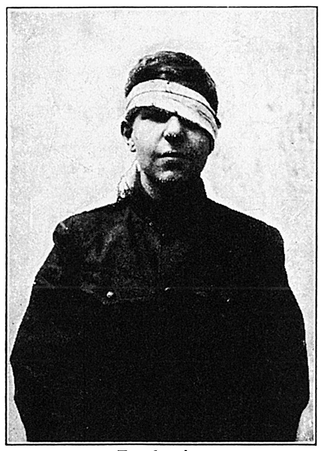
Eye bandage
Sunburn
This is simply an inflammation of the skin due to action of the sun. It may be prevented by hardening the skin gradually. Any toilet powder or boracic acid will protect the skin to a considerable extent. The treatment consists of soothing applications such as ordinary or carbolized vaseline.
Ivy Poisoning
Poison ivy causes a very intense inflammation of the skin. Better avoid, even though it has not harmed you before. Baking soda made in a thick paste with water or carbolized vaseline are good remedies. In severe cases a doctor should be consulted.
Bites and Stings
Ammonia should be immediately applied. Wet salt and wet earth are also good applications.
Nosebleed
Slight nosebleed does not require treatment as no harm will result from it. When more severe the collar should be loosened. Do not blow the nose. Apply cold to the back of the neck by means of a key or cloth wrung out in cold water.
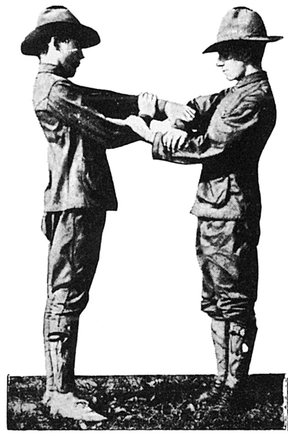
Position of hands
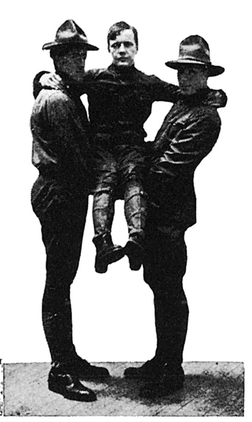
Chair carry
A roil of paper under the upper lip, between it and the gum, will also help. When the bleeding still continues shove a cotton or gauze plug into the nostrils, leaving it there until the bleeding stops.
Earache
This is likely to result seriously and a doctor should be consulted in order to prevent bad results with possible loss of hearing. Hot cloths, a bag of heated salt, or a hot bottle applied to the ear will often cure earache. A few drops of alcohol on a hot cloth so placed that the alcohol fumes enter the ear will often succeed. If neither is effective, heat a few drops of sweet oil as hot as you can stand, put a few drops in the ear and plug with cotton. Be careful that it is not too hot.
Toothache
Remember that toothache indicates something seriously wrong with the teeth which can only be permanently corrected by a dentist. In toothache if you can find a cavity, clean it out with a small piece of cotton or a toothpick. Then plug it with cotton, on which a drop of oil of cloves has been put if you have it. If no cavity is found, soak a piece of cotton in camphor and apply it to the outside of the gum. Hot cloths and hot bottles or bags will help in toothache, just as they do in earache.
Inflammation of the Eye
Cover with a cloth wrung out in cold water and change cloths from time to time when they get warm. See a doctor in order to safeguard your sight.
Cramp or Stomachache
This is usually due to the irritation produced by undigested food. A hot bottle applied to the stomach or rubbing will often give relief. A little peppermint in hot water and ginger tea are both excellent remedies. The undigested matter should be gotten rid of by vomiting or a cathartic.

Arm carry
Remember this kind of pain is sometimes due to something serious and if it is very severe or continues for some time, it is much safer to send for a doctor.
Hiccough
This is due to indigestion. Holding the breath will often cure, as will also drinking a full glass of water in small sips without taking a breath. If these fail vomiting is an almost certain remedy.
Chills
In order to stop a chill drink hot milk or hot lemonade and get into bed. Plenty of covers should be used, and hot water bottles or hot milk or lemonade help to warm one quickly.
Carrying Injured
A severely injured person is always best carried on a stretcher. The easiest stretcher for a scout to improvise is the coat stretcher. For this two coats and a pair of poles are needed. The sleeves of the coat are first turned inside out. The coats are then placed on the ground with their lower sides touching each other. The poles are passed through the sleeves on each side, the coats are buttoned up with the button side down. A piece of carpet, a blanket, or sacking can be used in much the same way as the coats, rolling in a portion at each side. Shutters and doors make fair stretchers. In order not to jounce the patient in carrying him the bearers should break step. The bearer in front steps off with the left foot and the one in the rear with the right. A number of different methods for carrying a patient by two bearers are practised. The four-handed seat is a very good one. To make this each bearer grasps his left wrist in his right hand, and the other bearer’s right wrist in his left hand with the backs of the hands uppermost. The bearers then stoop and place the chair under the sitting patient who steadies himself by placing his arms around their necks.

Improvised stretcher
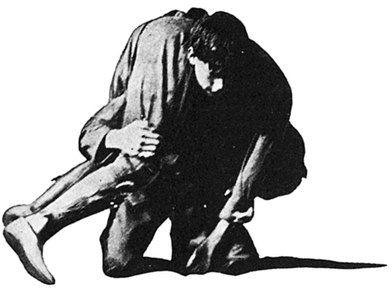
First position
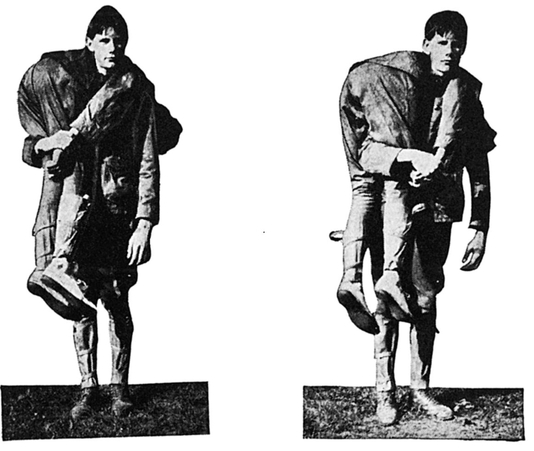
Fireman’s lift
It will sometimes be necessary for one scout to carry an injured comrade. The scout should first turn the patient on his face; he then steps astride his body, facing toward the patient’s head, and, with hands under his arm-pits, lifts him to his knees; then, clasping hands over the abdomen, lifts him to his feet; he then, with his left hand, seizes the patient by the left wrist and draws his left arm around his (the bearer’s) neck and holds it against his left chest, the patient’s left side resting against his body, and supports him with his right arm about the waist. The scout, with his left hand, seizes the right wrist of the patient and draws the arm over his head and down upon his shoulder, then, shifting himself in front, stoops and clasps the right thigh with his right arm passed between the legs, his right hand seizing the patient’s right wrist; lastly, the scout, with his left hand, grasps the patient’s left hand, and steadies it against his side when he arises.
WATER ACCIDENTS
The scout’s motto, “Be Prepared,” is more than usually applicable to the work of caring for accidents which happen in the water.
To save lives, the scout must know first how to swim, to care for himself, and then to learn to carry another and to break the clutch, the “death grip,” which we read so much about in the newspaper accounts of drowning accidents. By constant training, a boy, even though not a good swimmer, can be perfectly at home in the water, fully dressed, undressed, or carrying a boy of his own size or larger. In fact two boys of twelve or fourteen years can save a man.
Swimming
For physical development the breast stroke is useful, for it is one that is used in carrying a tired swimmer and is used to go to the bottom for lost articles and to search for a person who has sunk before help has reached him. It is possible, you know, to go to the bottom and bring a body to the surface and swim with it to shore before life is extinct and to restore consciousness by well-directed efforts. The body of an unconscious person weighs little when wholly or partially submerged, and in salt water weighs less than in fresh water, and is consequently more readily carried. Training makes a small boy the equal or superior of an untrained boy much larger and of greater strength, and the way to learn to carry a drowning person is to carry a boy who is not drowning to get used to handling the weights. A little struggle now and then lends realism to the work and increases the skill of the scout candidate for a life saver’s rating. Speed swimming for itself alone is a very selfish sport so that the scout should develop his ability to make it generally useful to others.
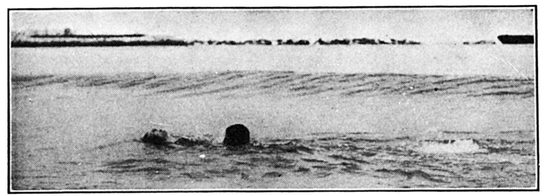
Breast stroke for tired swimmer
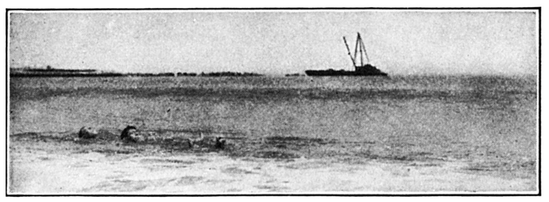
Under-arm carry
Floating
After the breast stroke is learned, floating on the back for rest and swimming on the back, using feet only for propulsion, leaving the hands free to hold a drowning person, should be learned. This can be readily acquired with a little practice, carrying the hands on the surface of the water, arms half bent, with the elbows close to the sides at the waist line. To carry a man this way the hands are placed at either side of the drowning man’s head and he is towed floating on his back, the rescuer swimming on his back, keeping the other away. It is well to remember to go with the tide or current, and do not wear your strength away opposing it. Other ways of carrying are to place the hands beneath the arms of the drowning man, or to grasp him firmly by the biceps from beneath, at the same time using the knee in the middle of his back to get him into a floating position, the feet acting as propellers.
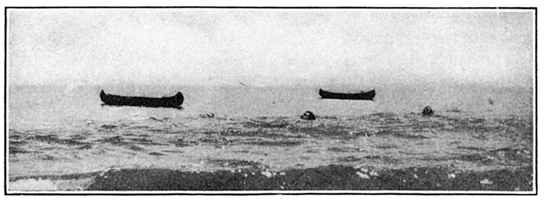
Swimming on back without hands

Head carry — swim on back
Methods which enable the rescuer’s use of one arm in addition to the feet are known as the “German army” and the “cross shoulder.” In the first, the swimmer approaches the drowning person from the back, passes the left arm under the other’s left arm, across in front of the chest, and firmly grasps the right arm, either by the biceps or below the elbow, giving him control. This leaves the right arm to swim with. The other one-arm hold mentioned is one in which the rescuer passes an arm over the shoulder of the one to be carried, approaching from the back as before, and getting a hold under the other’s arm, which makes the drowning man helpless. The breast stroke carry previously mentioned is used only for helping a tired swimmer, and one in possession of his faculties who will not try to grasp the rescuer. The tired swimmer lies on the back and, extending his arms fully in front, rests a hand on either shoulder of the swimmer who rests facing him in the regular breast position allowing the feet of the other to drop between his own. Quite good speed can be made in this way, and all of these methods are practical as a trial will show. A little practice will enable the beginner to see which he can do most readily and then he can perfect himself in it for instant use.
Breaking “Death Grips”
If one uses care in approaching a frightened or drowning person in the water, there will be no use for the release methods; but the best of swimmers get careless at times and all swimmer? need to know how to get clear when gripped.
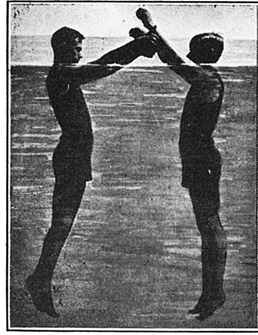
Break for wrist hold

Breaking back strangle hold
Wrist Grip
Of these the simplest is the one where the wrists of the swimmer have been grasped by the drowning man in his struggles. The swimmer throws both hands above his head which forces both low in the water and then turns the leverage of his arms against the other’s thumbs, breaking the hold easily.

Break for front strangle hold
It should be borne in mind that a drowning man grasps what he can see above the surface of the water, so he will not attempt to grasp his rescuer below the points of the shoulders. Remember also that a tall man and a short man would have about the same amount of their body projecting above the surface of the water.
Neck Grip
For the grip around the swimmer’s neck from the front, for both arms around the shoulders, and for a grip in which the drowning man had the other over one shoulder and under the other arm, the break is much the same. As soon as the rescuer feels the hold, he covers the other’s mouth with the palm of his hand, clasping the nostrils tightly between his first two fingers, at the same time pulling the drowning man to him with the left hand in the small of the back, treading water in the meantime. Then, taking a full breath, he applies his knee in the other’s stomach, forcing him to expel the air in his lungs and at the same time preventing him from getting more by pressure on the nostrils and mouth. Should the pressure of the grip around the body be too great to allow freedom of the arms, the preliminary move in that case would be to bring both arms to the level of the shoulder, thus sliding the other’s arms to the neck, leaving the rescuer’s arms to cover the nose.
Back Strangle
The back strangle hold is an awkward one to break and one which must be broken without an instant’s delay, or the would-be rescuer himself will be in great need of help. In practice it will be found that, by grasping the encircling arms at the wrists and pushing back with the buttocks against the other’s abdomen, room to slip out can be obtained. In a life and death struggle, sharper measures are needed, and if the rescuer throws his head suddenly back against the nose of the drowning man, he will secure his freedom very readily and have him under control by the time he has recovered from his dazed condition.
Rescue From Shore or Boat
It is not always necessary to go into the water to attempt a rescue, and in many cases, when some one has fallen off a bridge or dock, a line or buoy or boat can be used to advantage without placing more lives in danger than the one in the water. Discretion in such matters is worthy of recognition rather than too much recklessness in swimming out. Use a boat when possible. Practice in throwing a life buoy should be indulged in where possible, and a good scout should always leave the line coiled over pegs and the buoy hanging on top to bind it in place for instant use in an emergency.
Diving From the Surface
When a bather or victim from a boating accident sinks to the bottom of a river or pond of from seven to twenty feet in depth, prompt rescue methods may bring him to the surface, and resuscitation methods, promptly applied, will restore breath. If there is no current in the pond or lake, bubbles from the body will indicate its whereabouts directly beneath the place where it sank. Should there be tide or currents, the bubbles are carried at an angle with the streams and the searcher must go from the spot where the person disappeared and look along the bottom going with the current. When a drowning man gives up his struggle and goes down, his body sinks a little way and is brought up again by the buoyancy within it and the air is expelled. It sinks again and next rises less high and air is again expelled. This happens several times until enough water is taken into the stomach and air passages to offset the floating capacity. The floating capacity is barely overcome, so the body weighs but little. It is very simple, as almost any youthful swimmer knows, to go to the bottom if one can dive from a float, pier, or boat, but to be able to dive down ten feet from the surface requires practice. In most cases to go deeper would require a weight after the manner of the Southern sponge and pearl fishers. Grasp a ten or fifteen pound stone and dive in; to come up the swimmer lets go and rises to the top.

Throwing feet for dive from surface
Diving For Lost Objects
In covering a considerable area in search for bodies or lost objects, several ropes can be anchored with grapnels or rocks in squares and a systematic search thus maintained by divers. Going down from the surface is not so simple and the knack is attained by practice, especially by athletic lads. The secret is to swim to a point where a sounding is to be made, and to plunge the head and shoulders under, elevating the hips above the surface to drive the shoulders deep and give chance for a few strokes — breast stroke preferred — until the whole body in a vertical position is headed for the bottom. The elevation of the feet and lower legs in the air gives the body additional impetus downward, and when the object is attained a push-off from the bottom with both feet sends the swimmer to the surface in quick order. To carry any weight ashore, it is necessary to carry it low on the body, hugged close to the waist line, allowing one hand and both feet for swimming, or if on the back, hold by both hands using the feet as propellers.
Restoring Breathing
Knowledge of resuscitation of the apparently drowned is an important part of the equipment of a first-class scout, and a great many lives could have been saved had it been more general. To be effective no time must be lost in getting the apparently drowned person out of the water and getting the water out of him. The Schaefer or prone method requires but one operator at a time and no waste of time in preliminaries.
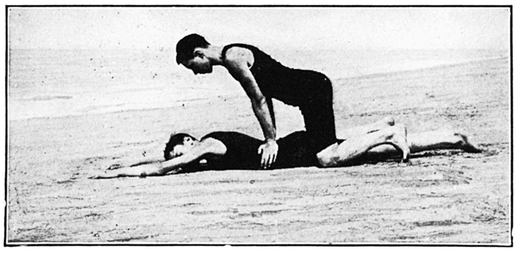
Artificial respiration (a)

Artificial respiration (b)
When taken from the water the patient is laid on the ground face downward, arms extended above the head, face a little to one side, so as not to prevent the free passage of air. The operator kneels astride or beside the prone figure and lets his hands fall into the spaces between the short ribs. By letting the weight of the upper body fall upon his hands resting on the prone man, the air is forced out of the lungs; by relaxing the pressure, the chest cavity enlarges and air is drawn in to take the place of that forced out. By effecting this change of air — pressing and relaxing, twelve to fifteen times a minute (time it by watch at first, and then count) artificial breathing is performed. Sometimes it is necessary to work an hour or two before the flicker of an eyelid or a gasp from the patient rewards the life saver’s efforts, and then he must carefully “piece in” the breathing until natural breathing is resumed. When breathing starts, then promote circulation by rubbing the legs and body toward the heart. Do not attempt to stimulate by the throat until the patient can swallow. Give a teaspoonful of aromatic spirits of ammonia, in half a glass of water.
Remember that by laying the patient face downward fluids in the air passages will run or be forced out and the tongue will drop forward, and require no holding, always an awkward task.
Treatment After Respiration Begins
The after treatment is important. Put the patient to bed, keep quiet and warm. Always get the services of a physician as soon as possible, but do not wait for him to come. Start work instantly. The patient needs oxygen, so keep spectators away. They are robbing the man of the life-giving properties of the air. For this reason, in all but the most severe weather, it is well to work on the patient in the open.
Life Buoys
If one is to place a life buoy for instant use in emergencies it should be hung upon four pegs driven into holes in two pieces of wood nailed together in the form of the diameter of a two-foot square or three pegs in strips of wood arranged in the form of a T, about eighteen or twenty inches high, the two pegs at either side of the top bar of the T and the other one on the upright near the bottom. Most life buoys used on shore have fifty or seventy-five feet of light line attached to draw the rescued person ashore or to recover the buoy after a faulty throw. Commencing at the free end of the line, where a small wooden float is often attached, the rope should first be coiled on the pegs, hanging the buoy outside the coil to bind it in place so wind or jars will not loosen it. Then, when the buoy is needed, the ring is grasped by the throwing hand which clasps the buoy itself, and the coil is clasped in the free hand, the end of the rope being secured ashore by standing upon it with one foot. After each use or practice the buoy line should be restored to its pegs for instant use.

Life buoy and ice ball
Notes
Notes